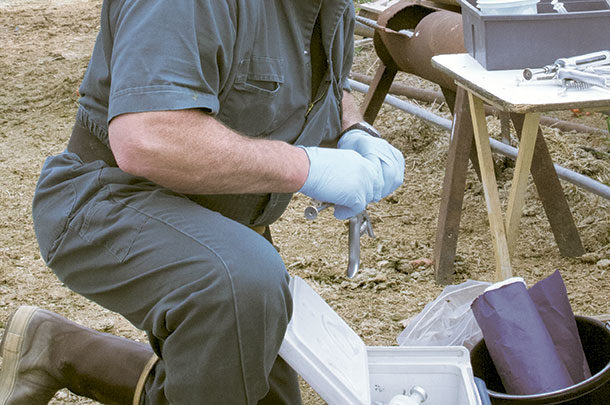We have all quoted, or at least heard, the age-old adage: “An ounce of prevention is worth a pound of cure.” Attributed to Benjamin Franklin, the old saying is the go-to phrase for opening discussions everywhere regarding biosecurity.
Though this saying is routinely quoted, and biosecurity regularly recognized as important, what does it mean day to day for the beef cattle operation? And with the ever-tighter margins in the beef industry, “prevention” still costs, so does biosecurity actually pay?
Let’s begin with a simple definition of biosecurity. The USDA-APHIS defines biosecurity as “… everything that’s done to keep diseases and pathogens that carry them away from [animals], property and people.” The USDA further breaks biosecurity into two categories, structural and operational. Of these categories, structural biosecurity is perhaps easier to identify.
Structural biosecurity involves the physical barriers in place to prevent the spread of pathogens and disease. A prime example of this would be pen separation: building pens such that new animals do not have nose-to-nose contact with animals already existing on the farm, for example. Commonly, structural biosecurity measures may be in place and not necessarily considered a day-to-day aspect of operating the beef farm.
Operational biosecurity, however, is the “practices, procedures, policies that are consistently followed,” according to the USDA. Operational biosecurity as the “ounce of prevention” may be arguably more challenging than structural biosecurity because it involves daily, vigilant attention to seemingly minute details on the farm. While operational biosecurity can include international and regional aspects, the focus of this article will be closer to home. What can be done to manage operational biosecurity between and within farms?
Between farms
When transporting animals between farms, or purchasing animals to bring to the farm, specific attention should be placed on simple practices. While cleaning a trailer is certainly not everyone’s favorite job, it can be an essential step in managing biosecurity threats between farms and even within farms by reducing exposure to pathogens during the stresses of transport.
If you have visitors coming to the farm to view or purchase cattle, or if you are swapping labor with a neighbor, require these individuals to take precautions to reduce the spread of pathogens. Ask your visitors to use boot covers or boot baths, when entering and leaving, to reduce the risk of unknown diseases coming to the farm or leaving the farm. In addition, you should have dedicated clothes and boots for your own farm. Wear different clothes or boots outside the facility, especially when visiting other farms or sale barn facilities. This is one of the cheapest and easiest means of biosecurity.
Aspects that may be more challenging, particularly for smaller producers, include testing all new animals before purchase or having closed breeding herds. While testing simply represents a challenge from the cost of it, closed herds are nearly unattainable on the beef operation because of the need to retain heifers on the farm and keep genetic diversity by introducing an unrelated bull. There are measures that can be taken within farm, though, to help prevent the spread of pathogens from incoming cattle.
Within farm
Within the farm, while the pens are part of your structural biosecurity, your operation and management of those structures can be crucial to successfully preventing the spread of pathogens around the farm. For example, maintaining cattle in the same groups and keeping neighboring pens consistent when possible will help limit the spread of disease. Neighboring groups will have similar diseases, but exposure to new neighboring groups can initiate spread of disease.
In addition to animal groups, consider the order of events in your daily routine. Avoid working with sick cattle before working with newly arrived cattle, for example. While it sounds intuitive, we sometimes rush to deal with that one sick calf because we know processing the others will take most of the day. However, if you process that sick calf first, you are exposing all cattle you work subsequently to that illness.
If maintaining a working order is simply not possible, disinfection before working newly arrived cattle can help prevent disease exposure to a high-risk group. Working order can be just as important between age groups. Young, high-risk cattle should be worked before more mature cattle that have stronger immunity against disease.
In addition to working order, consider changing clothes after working with sick cattle, especially if healthy cattle will be worked later in the day. Dedicated coveralls and boots for the hospital area, or providing disinfectant to scrub boots after working with sick cattle, can prevent spreading disease to healthy animals. While it can be slightly cumbersome and feel restrictive, wearing latex gloves while working with cattle can also help prevent spread of disease between groups of cattle when changed, especially when working in a designated sick pen or area.
Is it all really necessary?
Biosecurity can seem overwhelming when all these considerations are taken seriously. Some would say, “Why not avoid it altogether? Just purchase single-sourced, preweaned and vaccinated calves.” While purchasing single-source cattle that have been preweaned and have a known vaccination history is ideal when attempting to prevent the introduction of disease on the farm, it is not always feasible or possible.
The second-best method of preventing disease spread is to work with your veterinarian on the biosecurity measures you employ upon arrival of new animals and calves. Your veterinarian can help you develop arrival protocols for each group of cattle brought in. This may include a combination approach of vaccinations and other medication based on the source and risk level of cattle arriving. Different groups of cattle will likely need different protocols.
The benefits of biosecurity include reducing the spread of disease, improving productivity and decreasing the number of animals that need treatment. All of these benefits yield an economic return to the beef farm. So biosecurity pays. Period. ![]()
PHOTO: Wearing latex gloves as you work with cattle prevents the spread of disease between groups of cattle when changed, especially if you are working in a designated sick pen or area. Staff photo.
Hayley R. Springer is a veterinarian with Penn State University.

-
Tara L. Felix
- Beef Specialist
- Penn State Extension
- Email Tara L. Felix








